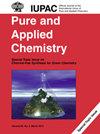Maximising the consistency of the presentation of the molecular level with its quantum mechanical description: challenges and opportunities
IF 2
4区 化学
Q3 CHEMISTRY, MULTIDISCIPLINARY
引用次数: 0
Abstract
Reasoning in terms of molecules has since long become fully embedded in any chemistry discourse. On the other hand, students’ familiarization with the molecular level in pre-university instruction is not always satisfactory, and their ability to view chemical phenomena in terms of what molecules do may not reach the extent and quality that would be needed to ensure effective conceptual understanding. Students may remain uncertain about the interpretation of the molecular features of a number of phenomena even through undergraduate instruction. Removing uncertainties and promoting comfortable familiarization is increasingly becoming an imperative for chemistry education, in view of the novel central role that the molecular level is acquiring not only for the customary interpretation of phenomena, but for the high variety of applications that have been blooming in recent years. Consequently, learners’ familiarization with the world of molecules needs to become more informative and complete. It is equally important that the information that they acquire about molecules be consistent with the modern descriptions, which are based on quantum mechanics. This requires accurate search for optimal balances between the need to simplify the terms of the descriptions in order to make them accessible to leaners according to the different levels of chemistry learning, and the simultaneous need to maintain adequate conceptual rigour. The present work outlines approaches which have proved viable and effective, and which rely on accurate use of language and visualization as the major explanation resources.最大限度地保持分子水平的表述与其量子力学描述的一致性:挑战与机遇
以分子為基礎的推理早已滲透到任何化學討論中。另一方面,學生在大 學前的教學中對分子層面的熟悉程度並不總是令人滿意,而他們從分子的作用來 看化學現象的能力,亦未必能達到有效理解概念所需的程度和質素。即使通过本科生的教学,学生对一些现象的分子特征的解释可能仍然不确定。鉴于分子水平不仅在现象的惯常解释中,而且在近几年蓬勃发展的各种应用中,正 在发挥着新的核心作用,消除不确定性和促进熟悉分子水平正日益成为化学教育的当务 之急。因此,学习者对分子世界的了解需要更加翔实和完整。同样重要的是,他们获得的分子信息必须与基于量子力学的现代描述相一致。这就需要准确地寻找最佳平衡点,既要简化描述的术语,使不同化学学习水平的学 生都能理解,又要保持足够的概念严谨性。本著作概述了已被证明可行和有效的方法,这些方法依赖于准确使用语言和可视化作为主要的解释资源。
本文章由计算机程序翻译,如有差异,请以英文原文为准。
求助全文
约1分钟内获得全文
求助全文
来源期刊

Pure and Applied Chemistry
化学-化学综合
CiteScore
4.00
自引率
0.00%
发文量
60
审稿时长
3-8 weeks
期刊介绍:
Pure and Applied Chemistry is the official monthly Journal of IUPAC, with responsibility for publishing works arising from those international scientific events and projects that are sponsored and undertaken by the Union. The policy is to publish highly topical and credible works at the forefront of all aspects of pure and applied chemistry, and the attendant goal is to promote widespread acceptance of the Journal as an authoritative and indispensable holding in academic and institutional libraries.
 求助内容:
求助内容: 应助结果提醒方式:
应助结果提醒方式:


